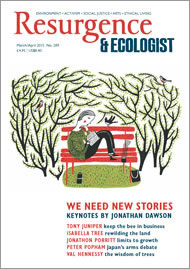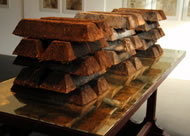Soil Culture is a programme that uses the arts to inspire a deeper public understanding of the importance of soil – a topic that has never captured the level of attention devoted to the conservation of such ‘charismatic megafauna’ as the giant panda or the humpback whale.
Not only are healthy soils essential for the production of food for a growing world population, but they are also a vital part of our global ecosystem, acting as a carbon sink to reduce the impact of climate change. They filter our water and protect us from flooding. They also provide fibres for our clothing, and timber for construction and fuel.
Today, soils around the world are increasingly being threatened by poor management and short-termism, resulting in compaction, contamination, erosion and salinisation, together with a loss of fertility, organic matter and biodiversity. In surveys conducted between 2002 and 2011 in south-west England alone (where our programme largely takes place), 38% of soils were revealed to be significantly degraded, leading to increased run-off and serious consequences for the wider environment.
Just as the first landscapes were painted on the walls of Roman villas in the 1st century BCE at a time of over-cultivation and deforestation, so can new art forms provide us with valuable tools to raise eco-consciousness: to help people appreciate the importance of their everyday surroundings and the resources they might take for granted or otherwise abuse. They can touch people in ways that science and conventional advocacy frequently fail us.
The linking of the words ‘soil’ and ‘culture’ may seem strange, but it should be remembered that the word ‘culture’ was originally used in the ‘agri-cultural’ sense, and it was only from the 16th century that it increasingly came to be used figuratively; as the soil was improved by good husbandry, so the mind was improved by education and the arts. Perhaps it is now time for the arts and education to help put culture back into the soil.
The author Graham Harvey noted in his 1997 book The Killing of the Countryside: “It remains the sobering fact that even in the age of global communications and the Internet, civilisation continues to depend on a few inches of topsoil for its very existence.” Indeed, the Soil Culture programme has its origins in conversations over a decade ago with Graham when I was curating an art exhibition on the history of British livestock farming, in the aftermath of the last foot-and-mouth epidemic – in particular on the damaging effects of insecticides and nitrogen fertilisers on the environment, which were increasingly being noticed in the 1960s.
The programme developed in earnest when, in early 2013, we entered into a partnership with Falmouth University, which then secured support for a period of research from the Arts and Humanities Research Council, which culminated in a forum in Falmouth last July that brought together over 90 artists, writers and environmentalists.
Soil Culture is now supported by Arts Council England, the British Society of Soil Science and South West Soils, and comprises 12 artist residencies across the South West and at Kew, eight of which have been selected from an open submission. By the end of last year the first five residencies had attracted 456 applications from 22 different countries, a strong indication of the increasing number of artists becoming engaged with environmental issues.
The residencies are being held in a wide range of organisations, from the Eden Project in mid Cornwall and the University of Exeter’s Environment and Sustainability Institute in Penryn to the new Hauser & Wirth arts centre in Somerset and Daylesford Organic Farm in Gloucestershire. Each host sets a different brief for the artist, but all offer dedicated time for experimentation and the development of new work, and unparalleled access to facilities and expertise.
Residency artist Debra Solomon, who contributed to the recent Restoring Our Soil course at Schumacher College, will show her work at Dartington’s gallery in May/June this year. Based in Amsterdam, Debra is the founder of Urbaniahoeve, which develops edible, ecological landscapes in city areas and produces fertile soils out of urban waste. An exhibition will bring together the results of all residencies and be shown across the South West, with a special presence in Bristol during its year as European Green Capital.
A second exhibition of work by a number of established international artists whose work has engaged with soils, sometimes over several decades, will be launched at Falmouth Art Gallery in September before going to Plymouth University in 2016. This will include work by Mel Chin, whose artwork uses special hyper-accumulator plants to extract heavy metals from contaminated land, and Paulo Barrile, herman de vries and Chicago-based artist Claire Pentecost. Claire’s work includes refashioning soil into the shapes of gold ingots, a reflection of its true worth. She says: “My soil ingots propose a new system of value based on living soil, a form of currency that anyone can create by composting.”
Both exhibitions will be accompanied by a range of participatory activities. During Dartington’s Food Fair in May, landscape architect Charlotte Rathbone will run a Tasting the Place workshop inspired by the work of Californian artist Laura Parker connecting the ‘taste’ of local soils with local wines and cheeses. Artist Peter Ward, whose painting accompanied Vandana Shiva’s article in Issue 288 of Resurgence & Ecologist, will run a workshop using earth pigments. He explains: “The adoption of earth pigments in my work has allowed me to celebrate that which inspires my existence – Nature itself.”
Of course, readers might have already noted that the United Nations has designated 2015 the International Year of Soils (IYS), and we are delighted that Soil Culture has been accepted as part of the official programme. The downside is that, against the expectation of the UN that governments of participating countries will support IYS contributions, Britain’s Department for Environment, Food and Rural Affairs (Defra) is currently denying us any funding that will go towards the raising of public awareness of the plight of our soils.
We find this surprising because, as early as 2005, Defra’s audit of soils-related education and awareness found that existing provision was hard to find and interpret. Although it indicated that exhibitions provided an excellent form of learning, it noted that no museum had produced one on the subject since 1984.
What perhaps we should find less surprising is that Defra’s lack of support is consistent with the role that the present government and farming unions played last year in wrecking the European Soil Framework Directive, an initiative that aimed to give our soils the same protection as air and water.
The Soil Culture residency exhibition at Dartington from 8 May to 19 June 2015 will focus on the work made by Debra Solomon during her residency at Schumacher College earlier this year.








